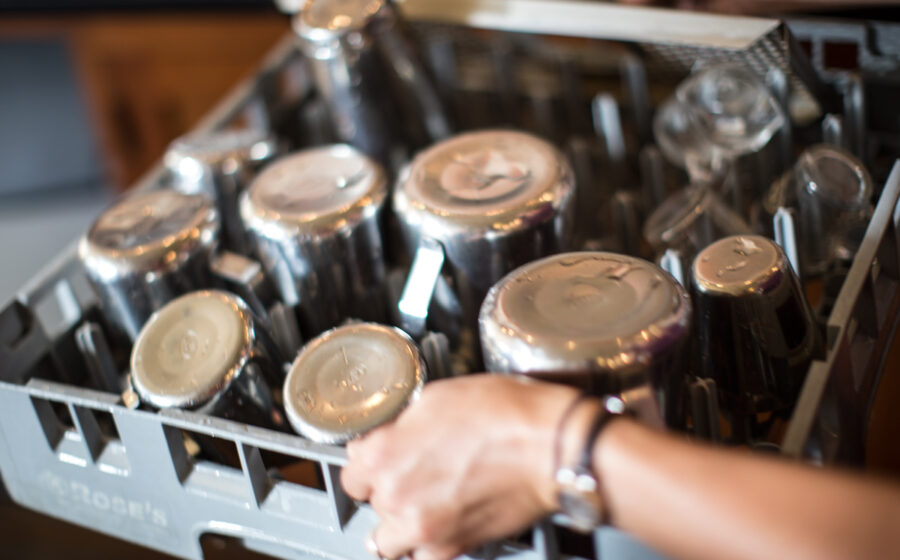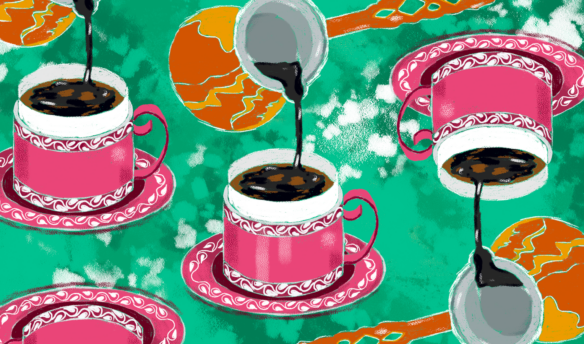[A]s I came around the counter to start my afternoon bar shift I was met by a visibly frazzled coworker. “I can’t get the espresso dialed-in!” the barista said. “It’s pulling to parameters, but it doesn’t taste good.” I glanced around the café, spotting unfolded rags and overflowing dish tubs. It clearly had been a busy morning. “When was the last time you dropped the screens?” I asked. The surprised barista sheepishly looked for an excuse. A few twists of a flathead screwdriver later and we were looking at half-a-day’s worth of espresso fines caked on so thickly the stainless steel was all but eclipsed. A quick wipe with a microfiber towel followed by a black-flush cycle and the espresso was tasting as good as ever.
The experience confirmed two beliefs I’ve developed over the last several years. First, cleanliness and routine maintenance of equipment have an enormous impact on beverage quality. Simply put, you can’t make tasty coffee with dirty equipment. Second, few baristas pay adequate attention to equipment maintenance. The irony is that this is where most cafés can improve their quality immediately. Although skills such as tamping and pouring latte art can take months if not years to develop and fine-tune, better bar practices can be implemented overnight. I would go so far as to say that all great cafés must have systems in place to ensure proper cleaning and maintenance of equipment.
Cleanliness and routine maintenance of equipment have an enormous impact on beverage quality. Simply put, you can’t make tasty coffee with dirty equipment.
If your company is large enough to cover the expense, having one of your baristas become a certified technician is a great investment. Most equipment manufacturers offer weeklong immersion programs to become a certified technician. Even if that’s not in the cards for your café, there are several practices you can implement immediately to raise the quality of your beverages and prevent equipment failure. Baristas should be trained on these practices and expectations should be clearly communicated. These tasks should be treated as seriously as properly brewing coffee, counting down the drawer, or locking the door at night.

Perhaps the cheapest investment a café can make for better maintenance is a shop vac. Although it doesn’t eliminate the need for a periodic deep clean, vacuuming out your grinders every night is one of the easiest ways to extend their lives. Even the best espresso grinders retain a fair amount of grounds in the chute. The residual oils in the grounds can lead to clogging and a host of other problems. To clean out your grinder, simply remove any left over coffee from the hopper. Hold the shop vac nozzle up to the chute and purge while running the vacuum. Repeat until you don’t see any more coffee come out. Espresso hoppers should be emptied and cleaned nightly as well.
As my coworker discovered, grouphead screens should be dropped at least every two hours, otherwise overextracted coffee fines will add a bitter, dirty taste to each shot. A spray bottle of water can also do a great job flushing coffee residue out of hard-to-reach crannies of the grouphead. If you use spouted portafilters it’s a good idea to periodically pop out the baskets and clean out the interior. This is easier with some espresso machines than others.
Scale is the silent killer of coffee shop equipment. The inner workings of your espresso machine or hot water tower tend to be out of sight and out of mind. But over time, calcium and other mineral deposits can clog valves and destroy heating elements.
“If you think about the way an espresso machine works, you’re constantly boiling water. Any minerals in the water are going to be left behind,” says Kenny Smith, co-owner and lead technician at Coffee Wrench, a Louisville-based company that services and restores coffee equipment. In addition to inhibiting proper coffee extraction, neglected water quality can lead to total equipment failure. “You end up in a situation where water can’t get through and you can’t make drinks for anyone.” As popular as cold brew might be right now, it won’t tide you over if your hot water tower or espresso machine fail. A far better strategy is to systematically change your water filters.
Depending on your location, improving your water quality might entail a reverse osmosis water system, as my place of employment, Quills, discovered when we opened a café in Indianapolis last year. (The city is wonderful but the water is terrible.) If you’re lucky enough to have water that is soft enough for a conventional filter, create a log for tracking filter changes. You could even make a recurring calendar notification to remind you when it is due for a change. If you’ve let your water filtration slip, you should consider doing preventive descaling before the problem escalates.

“It’s scarring for a lot of people, but the best way to descale a machine is manually,” says Smith. “I’m not a huge fan of putting chemicals in your machine if you can avoid it.” At the Coffee Wrench, Smith uses an ultra sonic cleaner after manually removing most of the scale. This device uses high frequency vibrations to polish metal. For most cafés, however, a tool as simple as a flathead screwdriver can be used to scrape out the boiler. Smith warns that any coffee equipment should be unplugged before doing any maintenance. And check your paperwork. Some maintenance can only be done by professionals or you’ll lose your warranty.
Finally, any equipment that regularly comes in contact with coffee, whether portafilters, airpots, or pour-over cones, should be regularly cleaned with Cafiza or another espresso machine cleaner. These cleaners are specially engineered to break down coffee oils that soap and water won’t touch. I love cleaning out my regular customers’ travels mugs with Cafiza, and seeing their eyes go wide as the coffee stains dissolve.
Implementing these simple, repeatable practices is the easiest way to improve quality at your coffee shop. Your café will look better and your drinks will taste better, and it might just save you ten grand on a new espresso machine.
—Michael Butterworth is director of education and a barista at Quills Coffee. He blogs at the Coffee Compass.















